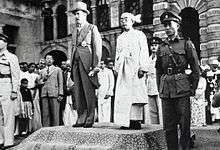Hubert Rance
| Major General Sir Hubert Elvin Rance GCMG GBE CB | |
|---|---|
| Governor of Burma | |
|
In office 31 August 1946 – 4 January 1948 | |
| Preceded by | Charles Alexander Innes |
| Succeeded by |
Sao Shwe Thaik (as President) |
| Personal details | |
| Born | 1898 |
| Died | 1974 (aged 76) |
| Nationality | British |
| Occupation | Administrator |
Major General Sir Hubert Elvin Rance GCMG GBE CB (1898–1974) was the last British Governor of Burma (Myanmar) between 1946 and 1948, during the transition from Japanese to British colonial administration. Later he became Governor of Trinidad and Tobago.
Career to 1945
Rance joined the British Army in 1916 and fought in the First World War with the Worcestershire Regiment. Later he transferred to the Signal Corps and in the Second World War played a part in the evacuation of Dunkirk in a senior role with the British Expeditionary Force. He also held senior War Office posts directing army training.
Burma

In 1945 he was appointed Director of Civil Affairs in Burma, restoring British control after Japanese forces withdrew. Reginald Dorman-Smith was appointed Governor in 1946 but UK Prime Minister Attlee, advised by Lord Mountbatten of Burma, soon decided that Rance should replace him. Dorman-Smith's imprisonment of a popular nationalist leader, Aung San, had provoked anger and the threat of rebellion against the British, while Rance had a more conciliatory approach.
British policy started to move away from an attempt at a slow, gradual transition to independence, and it was decided that Rance should co-operate with Aung San and his Anti-Fascist People's Freedom League. Aung San was believed to be less hostile to British interests, and less radical in his nationalism than some other political figures, like the communists, for example.
Rance became Governor on the last day of August 1946, and on 27 January 1947 Attlee made an agreement with Aung San that independence would come as soon as possible, with elections in April. British hopes of a smooth handover of power allowing the UK to retain some influence were threatened when Aung San was assassinated in July 1947. Rance's prompt action in making U Nu prime minister within hours is believed to have been a decisive factor in avoiding greater upheaval.[1]
In a formal ceremony on 4 January 1948 Rance handed over to Sao Shwe Thaik, president of Burma, while Nu continued as prime minister.
By the time he left Burma, Rance had retired from the army. His formal title was Major General Sir Hubert Elvin Rance, GBE, CB, and in 1948 he was made a GCMG.
West Indies
He acted as British governor of Trinidad and Tobago between 19 April 1950 and June 1955. He is author of two reports published by the Colonial Office in London in 1950: Development and welfare in the West Indies, 1947-49 and Report of the British Caribbean Standing Closer Association Committee, 1948-49 and in May 1956 he published an article on Burma’s Economic Problems in the Eastern World. Hubert Rance Street in Vistabella, San Fernando, Trinidad and Tobago was named in his honour.
Sources
- Clive Christie, The Karens in Turbulent Times and Enduring People (2000) ed. Jean Michaud]
- William Roger Louis, Dissolution of the British Empire in The Oxford History of the British Empire (1999) ed. Brown, Louis, Low
- Burma: The Curse of Independence (2001)]
- British in Burma (Encyclopaedia Britannica)
- King's College Military Archives
- DNB articles on U Nu and Dorman-Smith
Further reading
| Government offices | ||
|---|---|---|
| Preceded by Sir Reginald Dorman-Smith |
Governor of British Crown Colony of Burma 1946 |
Succeeded by Sir Reginald Dorman-Smith |
| Preceded by Sir Reginald Dorman-Smith |
Governor of British Crown Colony of Burma 1946–1948 |
Succeeded by President of the Union of Burma Sao Shwe Thaik |
Category:Burma in World War II